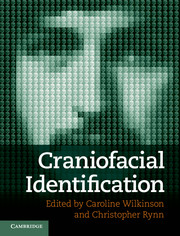Book contents
- Frontmatter
- Contents
- Contributors
- Part I Identification of the Living
- Chapter 1 Familiar face recognition
- Chapter 2 Unfamiliar face recognition
- Chapter 3 EFIT-V
- Chapter 4 Facial recall and computer composites
- Chapter 5 Facial ageing
- Chapter 6 Age progression and regression
- Chapter 7 Computer-assisted age progression
- Chapter 8 Facial recognition from identification parades
- Chapter 9 Virtual human identification line-ups
- Chapter 10 Computer-generated face models
- Chapter 11 Recognising and learning faces in motion
- Chapter 12 Facial image comparison
- Chapter 13 Three-dimensional facial imaging
- Part II Identification of the Dead
- Index
- Plate Section
- References
Chapter 11 - Recognising and learning faces in motion
Published online by Cambridge University Press: 05 May 2012
- Frontmatter
- Contents
- Contributors
- Part I Identification of the Living
- Chapter 1 Familiar face recognition
- Chapter 2 Unfamiliar face recognition
- Chapter 3 EFIT-V
- Chapter 4 Facial recall and computer composites
- Chapter 5 Facial ageing
- Chapter 6 Age progression and regression
- Chapter 7 Computer-assisted age progression
- Chapter 8 Facial recognition from identification parades
- Chapter 9 Virtual human identification line-ups
- Chapter 10 Computer-generated face models
- Chapter 11 Recognising and learning faces in motion
- Chapter 12 Facial image comparison
- Chapter 13 Three-dimensional facial imaging
- Part II Identification of the Dead
- Index
- Plate Section
- References
Summary
Introduction
This chapter reviews the role of motion when recognising already familiar faces and when learning new faces. This issue is interesting since, historically, face perception research has utilised static images of faces, with little consideration for the potential role of dynamic information created by seeing a face in motion. Much recent research has suggested that dynamic information contributes important additional information both when recognising familiar faces and when learning new ones. In this chapter we also introduce some of our own recent research which aims to investigate the importance of seeing own-race and other-race faces moving at encoding and testing. The practical and theoretical implications of our results are discussed.
Face recognition in humans is a highly developed visual perceptual skill. Face processing is performed by a distributed cognitive system likely to have evolved in the very distant past in evolutionary history (Pascalis and Kelly, 2009). Faces are naturally intricate structures composed of multiple complex features (e.g. eyes), which are themselves constructed from multiple lower-level features (e.g. contrast, frequency, orientation), located and orientated according to a unique configuration (Peterson et al., 2009). Despite this, in everyday life, the task of recognising and identifying individuals from their face is undertaken with relative ease and with little apparent effort (Christie and Bruce, 1998). We recognise faces from all directions under many different viewing conditions (Christie and Bruce, 1998). Variations in lighting and viewpoint, among other non-optimal viewing conditions, are encountered in everyday life yet recognition remains highly accurate (Hill et al., 1997; Braje et al., 1998). We are also adept in identifying particular characteristics from unfamiliar faces, such as their age, sex, race and emotional state with incredible accuracy (McGraw et al., 1989; Montepare and Zebrowitz, 1998). Accordingly, psychologists have long been interested in when face perception is optimal, and in particular have been keen to understand the cognitive processes that occur during face perception.
- Type
- Chapter
- Information
- Craniofacial Identification , pp. 125 - 135Publisher: Cambridge University PressPrint publication year: 2012



